It might start with mild shoulder pain. So you avoid certain exercises. No biggie. But this leads to atrophy of shoulder muscles and instability.
Then you start to notice impingement due to the atrophy. Then you notice strength and posture imbalances. The downward spiral has begun.
Next thing you know, your kids are dropping you off at the nursing home in time for Thursday afternoon shuffleboard. You’ll have the posture of Quasimodo and arms like T-Rex.
What is the rotator cuff?
The shoulder has an immense range of motion — the most of any joint in the body. But this comes with a catch: because of its range, it’s also the most unstable.
As a result, nearly 70% of us will experience some sort of shoulder disorder in our lifetime. Often, the injury includes one of the rotator cuff muscles.
Of all the injuries that take place during resistance training, 36% occur at the shoulder complex. The supraspinatus muscle is most often involved.
The rotator cuff is made up of four muscles (or you could think of them as “active ligaments”) that collectively compress, depress, protect and stabilize the glenohumeral joint, helping to keep the upper ball of the humerus (think of this as a golf ball) in the glenoid fossa (think of this as a tee). Weak rotator cuff muscles prevent the humeral head from rotating properly on the glenoid fossa.
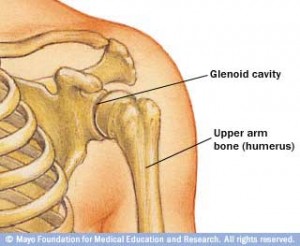 |
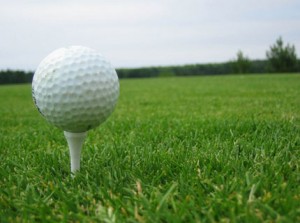 |
The supraspinatus, infraspinatus, teres minor, and subscapularis (the 4 rotator cuff muscles) originate on the scapula (shoulder blade) and help with various movements like bringing your arm out to the side, internal rotation (turning your arm inwards), external rotation (turning your arm outwards), and so on.
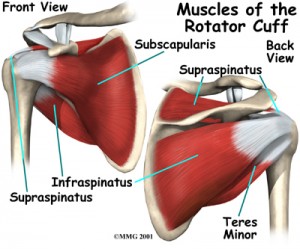
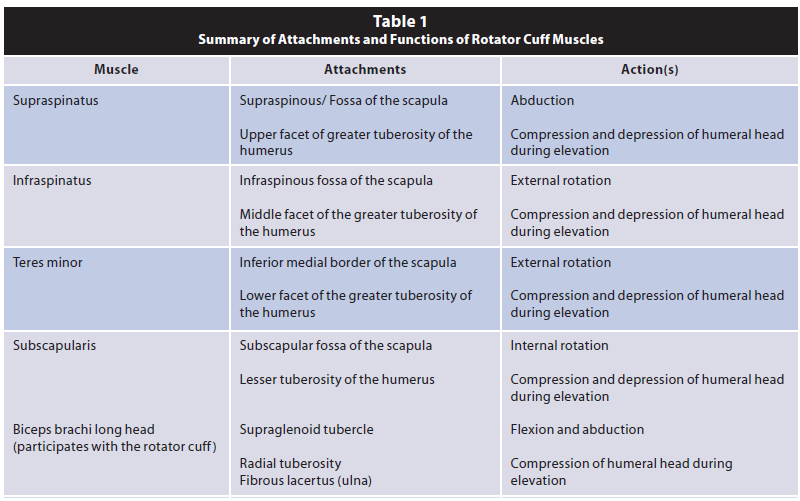
Source: Ronai P. Exercise modifications and strategies to enhance shoulder function. Strength and Conditioning Journal 2005;27:36-45.
Why is the rotator cuff important?
The challenge of stabilization
Shouder stabilization is a dynamic activity. Many muscles, from small to large, fire in a coordinated effort to stabilize the shoulder as it moves through a range of motion. Along with the rotator cuff, this includes:
- Serratus anterior
- Rhomboids
- Trapezius
- Levator scapulae
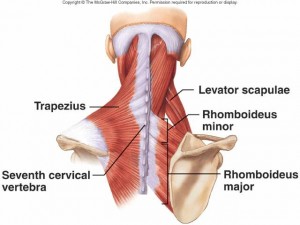 |
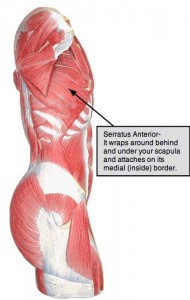 |
When looking at shoulder problems, it’s important to understand the complex roles that all of these muscles play. If they don’t work together — or more likely, if some muscles are strong and some are weak or inhibited, they can’t work together effectively in order to keep that golf ball on the tee.
The result: imbalance and eventually, injury.
68% of people with scapular instability have rotator cuff problems. If these muscles are weak or not firing properly, it’s harder to control that golf ball on the tee. Typically, the shoulder blades and the top of the humerus (upper arm) start to slip forward, which shrinks the subacromial space between the humerus and the acromion (bony structure at the top of the shoulder).
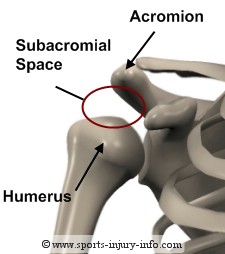
Many tendons pass through this space. When it’s constricted, these tendons can become inflamed. Over time, with repeated trauma, the tendons may become damaged or even — eventually — tear.
In addition, the surfaces and structures of the joint (such as the cartilage that lines the joint capsule) can become inflamed.
Shoulder injuries: You could be next
Barring an acute event (like falling on an outstretched arm), most shoulder injuries come from repeated, cumulative damage.
The bad news: Almost everyone is at risk for shoulder injuries.
The subscapularis tends to get plenty of stimulation in our “front-of-the-body-internal-rotation” happy gyms. This means it’s usually pretty tight and strong. Combine this with things like:
- desk work
- driving
- using a mouse/keyboard
- stress (which often makes people tighten up their traps and hunch their shoulders)
- sitting/standing in “hunchback” posture
- lack of attention to the muscles you can’t see in the mirror
…and you have the perfect storm for shoulder pain.
Many people ignore the warning signs of shoulder trauma (such as pain and limited mobility) until the situation is serious.
Don’t go like that.
Whether you feel pain while bench pressing, reaching overhead, throwing, punching, paddling, or all of the above… if your shoulder hurts, take the time to deal with it immediately. Don’t push through the pain. It will not get better if you ignore it, and will probably get worse.
The good news: A strong, stable and flexible rotator cuff can preserve shoulder health and increase upper body strength.
Preventing injury
One of the keys to injury prevention is developing flexibility of the subscap and pecs while building strength and endurance in the opposing external rotators.
- Anterior (front) shoulder instability, limited internal rotation mobility, and posterior (rear) shoulder tightness
- Excessive external rotation mobility
- Internal rotators stronger than external rotators
- Weak lower traps (usually combined with over-active and tight upper traps)
- Poor proprioception
Anterior shoulder instability, limited internal rotation mobility and posterior shoulder tightness
Remedy – Need to improve posterior shoulder flexibility
Discussion – If you can’t do this, you have some tightness in the back of your shoulder. Posterior shoulder tightness may be a contributing factor in impingement and labral tears. This tightness doesn’t allow adequate internal rotation or horizontal adduction.
Exercises to consider:
- Cross arm adduction stretch
- Internal rotation sleeper stretch
- Scapular wall slides
- Shoulder dislocates
- Unilateral presses and pulls (one side at a time)
- Medicine ball wall tosses
- Drop and catch push up (advanced)
Excessive external rotation mobility
Remedy – Need to increase internal shoulder rotation
Discussion – This is a rare shoulder problem to have; though it’s often seen in “overhead athletes”: folks whose sport involves throwing or pressing overhead, such as pitchers. With poor internal rotation flexibility, posterior shoulder tightness ensues. This can lead to the posterior rotator cuff muscles contracting with more force in an attempt to pull the humeral head back into place, leading to rotator cuff muscle fatigue and injury.
Exercises to consider:
- Cross arm adduction stretch
- Internal rotation sleeper stretch
Internal rotators stronger than external rotators
Remedy – Need to strengthen the external rotators
Discussion – The teres minor and infraspinatus are major external rotators involved with abduction and overhead motions.
Exercises to consider:
- Face down Y exercise
- Face down T exercise
- Band external rotation at 30 degrees abduction
- Seated press ups (advanced)
- Power wheel crawls (advanced exercise – starts at 1:42 in video)
- Pushup plus
- Reverse push up
- Cable external rotations at 90 degrees
- Side lying external rotation at 30 degrees abduction
- Scarecrow
Notes on the above exercises:
Performing these exercises on unstable surfaces can further enhance sensorimotor control.
Placing a towel between the arm and body during internal/external rotations can decrease deltoid activity, relax the supraspinatus, and lessen pain – all good for the prehab/rehab process.
Weak lower traps
Remedy – Need to strengthen the lower traps
Discussion – An important sign of good shoulder function during pushing and pulling movements is the ability to keep the shoulders down and away from the ears.
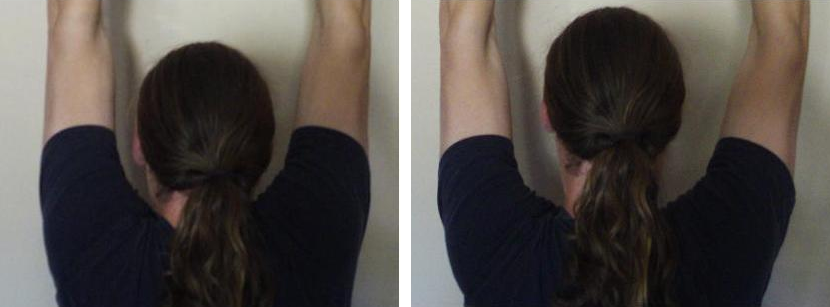
If the shoulders move up toward the ears during a pushup or row (as in the left-hand photo above), it signifies greater upper trap activity. This yanks the humerus out of alignment within the glenoid cavity (the golf ball on the tee) which results shoulder complex muscle weakness and limited range of motion. This is a particular problem because the upper traps can be so strong relative to other muscles.
Another screening tool is kyphotic posture, aka “the Quasimodo” or “E.T.” Again, this suggests the upper traps are considerably stronger than the mid- to low traps, serratus anterior and levator scapula.
Exercises to consider:
Balance out all of your pushing exercises with pulling exercises (using retracted shoulder blades)
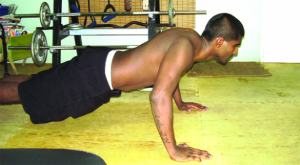 |
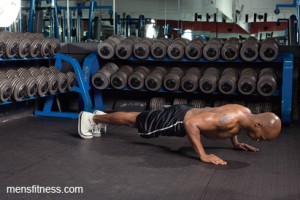 |
| Push up with some shrugging – not good | Push up without shrugging – good |
Poor proprioception
Remedy – Need to build proprioception — awareness of where the body is in space.
Discussion – Damage to ligaments around the shoulder cause less sensory information coming in. Without proper incoming information, the shoulder isn’t protected from extreme ranges of motion.
Exercises to consider:
- Swiss ball pushups (advanced)
- 1 arm ab plank on swiss ball (advanced)
- Medicine ball wall dribbles or this option
- Quadruped rhythmic stabilization
The following are advanced plyometric exercises helpful for later stages of rehab/prehab.
Tips on rehab/prehab exercises
When shoulder muscles become fatigued, the joint becomes hyper mobile, and prone to injury. Thus, building endurance is important.
When doing shoulder stabilization exercises, use higher reps (10-20), and/or longer duration (e.g. 30-60 sec).
Also, it’s important to train external rotators with an emphasis on the eccentric phase. Use the “4-6” approach for the direct rotator cuff exercises. Use a 4 second count on the concentric phase and a 6 second count on the eccentric phase.
Don’t try this at home
A dangerous position for the rotator cuff (and the shoulder), is the “high five position.” The humerus is abducted (held away from the body) and externally rotated. This overloads the anterior capsule.
Beyond actually high fiving with buddies, this position is often replicated in the gym during old-school machine chest flies, behind the neck pulldowns, and behind the neck presses.
Other exercises that may increase shoulder injury risk include bench press (flat and incline), dips, barbell back squats, upright rows, dumbbell flies, and arm curls.
The empty can position (raising the arms up with the palms down/back) can inflame the shoulder by reducing the subacromial space and causing impingement. Instead, use the full can exercise (raising the arms up with palms forward in the plane of the scapula).
Modifying exercises to improve shoulder health
Here are some tips to help you adjust common exercises to maximize shoulder health.
Bench press
- Tuck elbows a bit closer to your body
- Use a neutral grip with dumbbells – like this: Dumbbell Bench Press, Neutral Grip
- Don’t feel like you need to go down all the way until your elbows dip below your body – try floor presses: Lazy Floor Press or Regular Floor Press
- Retract your shoulders before starting a press
Change your squat
Instead of standard barbell back squats, try front, zercher, dumbbell front or goblet squats, which put less stress on the shoulders.
Pulldowns and overhead presses
- Bring elbows slightly forward instead of flared out
- Always go to the front of the body
Keep it scapular
When raising your arm out to the side, don’t force it back so it’s directly in line with your body. Keep it in the natural range of motion with the scapula – like this: Scapular Plane Lateral Raise, Neutral Grip
Upright rows
Not worth it. Try face pulls instead.
Posture
Keep a proud chest, tight shoulder blades, engaged core, and overall “good posture” when exercising (and with daily life).
Other exercise modifications
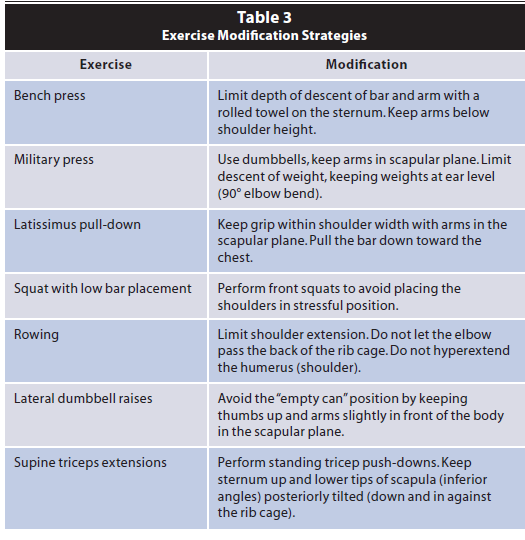
Summary and recommendations
- If it hurts your shoulders, avoid it. And don’t work through pain.
- Activate your serratus (see shoulder circuits below) to save your shoulders.
- Move around during the day. Check your posture.
- If you do a push, follow with a pull. If you work your front, follow with your back. In fact, try to do more pulling than pushing — about a 2:1 ratio if possible.
- Don’t be afraid to nix shoulder day. Between other exercises, the shoulders get plenty of work.
- Use massage or active release therapy to keep soft tissues happy.
- As much as possible, alternate which hands you use for daily-life tasks, such as brushing your teeth.
- Foam roll the thoracic spine.
- Be cautious with explosive overhead lifts.
- Develop shoulder flexibility/mobility/strength with the circuits below.
Here are two sample preventive stretching/strengthening circuits for shoulder health.
Do each circuit 1-2 times per week.
Aim for 1-2 sets of about 10 reps per exercise. If the exercise works one side at a time, make sure to do 10 reps for the other side too. If it’s a timed exercise, aim for 15-20 seconds.
On your regular workout days, try this circuit before or after your scheduled workout (or, if you want, at a completely different time than your workout). On your non-workout days, try the routine any time of day. It shouldn’t take longer than 10 minutes once you’ve got it down.
All of these exercises should be nice and easy. Resistance should be light; this is not a max strength workout.
Circuit A
A: 1 arm ab plank on Swiss ball (advanced – don’t break your nose)
B1: Reverse push up
B2: Pushup plus
C: Scarecrow (4 seconds concentric, 6 seconds eccentric)
D: Foam roll the thoracic spine
Circuit B
B: Band external rotation at 30 degrees abduction (4 seconds concentric, 6 seconds eccentric)
Extra credit
Co-activation of the traps and serratus anterior are thought to have significant influence on scapulohumeral rhythm.
The infraspinatus and teres minor are extremely active during the “follow-through” with overhead throwing motions (or some overhead exercises like medicine ball slams). Train these muscles eccentrically.
References
Click here to view the information sources referenced in this article.
Learn more
Want to get in the best shape of your life, and stay that way for good? Check out the following 5-day body transformation courses.
The best part? They're totally free.
To check out the free courses, just click one of the links below.



Share